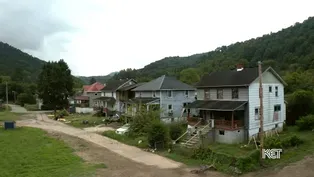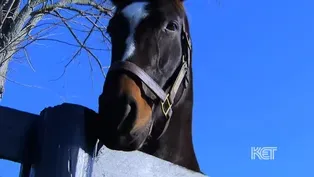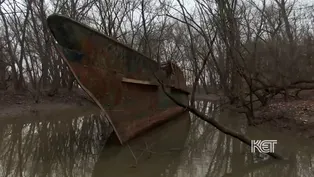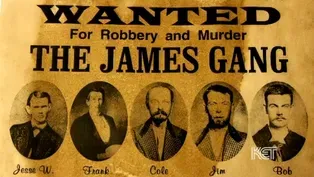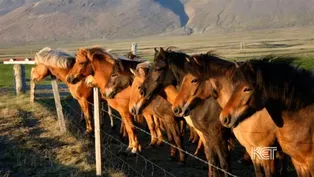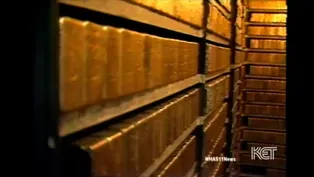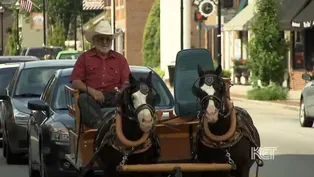
Eastern Kentucky Flood
Clip | 13m 40sVideo has Closed Captions
The 2022 devastating flooding in Eastern Kentucky and how the community is recovering.
Survivors recount their experiences during the 2022 devastating flooding in Eastern Kentucky and share how the community is recovering.
Problems with Closed Captions? Closed Captioning Feedback
Problems with Closed Captions? Closed Captioning Feedback
Kentucky Life is a local public television program presented by KET
You give every Kentuckian the opportunity to explore new ideas and new worlds through KET. Visit the Kentucky Life website.

Eastern Kentucky Flood
Clip | 13m 40sVideo has Closed Captions
Survivors recount their experiences during the 2022 devastating flooding in Eastern Kentucky and share how the community is recovering.
Problems with Closed Captions? Closed Captioning Feedback
How to Watch Kentucky Life
Kentucky Life is available to stream on pbs.org and the free PBS App, available on iPhone, Apple TV, Android TV, Android smartphones, Amazon Fire TV, Amazon Fire Tablet, Roku, Samsung Smart TV, and Vizio.
Providing Support for PBS.org
Learn Moreabout PBS online sponsorshipA flood of this proportion.
I don't think there's any history to it.
Well over a hundred years.
We can't document a flood with this kind of devastation.
When you get the kind of rain that we got in the wintertime, we got it in these mountains.
You're not gonna stop when you get that type of rain on ground that's already saturated from a week's worth of rain before this.
It won't handle It can't.
For me this is home We moved here when I was five years old.
And that was the beginning of a love affair with this little town located in southwest Floyd county, where probably 20 miles, 20 minutes from the county seat of Prestonsburg.
The deep mines closed in 1954.
With it went many of the jobs.
And with the jobs went the people.
We have been flooding here for a hundred years.
And so flooding in and of itself is not something unusual.
As a matter of fact, we had three floods earlier this year before this last one came.
Think about that.
Four floods in one year.
And so flooding in and of itself is not a traumatic experience.
The last one was.
3:30 in the morning.
My neighbor calls and says Jerry the water's getting up.
Now we have markers and we look and we kind of know how much time we have in a typical flood.
So at 3:30 in the morning, I wake my wife.
We go downstairs and we start to move some things out of our basement.
Typically an hour and a half to 2 hours from where the markers are we probably can get out of the basement what we need to get out of.
Expecting two, three, four feet of water, maybe five at on occasion, begin to move a few things and the water moved from one marker to another marker in about 15 minutes, which was unusual.
So we kind of sped the process up a little bit after maybe the second or third trip, the water was moving at a different pace and we could see that it was obvious that it was moving quicker than a normal flood.
So I said, Let's move the cars.
That's usually the last thing we move.
We move the cars, which took maybe 5 minutes to higher ground.
And in those 5 minutes when I came back, I waited in about knee deep into my basement.
That's how quickly the water came in, about a 15 to 20 minute period.
Water went from the original marker to being in a basement, another load or two out.
I was waiting out waist deep.
One more trip and when I came out to the last time it was that close to my shoulders, I was carrying things above my head to get it out of there.
That has never happened.
Never had happen.
So I live up on the hill and it blew the screen out of my window that night.
And I was like, Wow.
The storm is raging in the next morning.
And I got up and I still had water and I still had electricity.
I had no idea what had happened.
Below, All the culverts were upended in the creek and I could tell that the dirt was washed out from under the pavement out here.
Then there was this big gaping hole right in front of the gate half of the highway was gone People were walking the roads that day and I came here because we had wifi and could get on it to try to get in touch with relatives.
One guy comes in and sits down and he’s just sitting there kind of with his head hung down.
I'll never, never forget, he said when you go to bed and everything that you've worked for is there.
And then you get up the next morning and it's all gone.
You can tell how high this water’d gotten by the debris line.
You think of how much water it took to fill that up As you can see, what's left of these homes that were sitting down here, there were multiple just a pile of wood.
First few hours after the flood.
I mean, the only way I can describe it was chaos.
A lot of people frantically scrambling around trying to save what possessions they could and ultimately trying to save their lives.
Kentucky State police received over 130 missing person complaints, as well as over a thousand welfare checks for individuals in the communities that we serve Going out into the community and seeing the devastation that took place is just absolutely humbling.
You know, I've traveled around the state and worked in different places, but this is different this is home.
These people here, they've been through a lot They’re tough people They’ve had to fight their entire lives.
It’s a very poor community.
However, that doesn't take away from the caliber of people that live here.
I know people that lost their homes, cars, everything, and are still out trying to help their neighbors clean up what they can.
Now You tell me how somebody who just lost everything they have is that selfless, that they're still able to go out and help their community.
And that just is a testament to the type of people that live here in the mountains.
I've lived in eastern Kentucky my entire life.
I think this is not just a mentality for myself, but for everyone here.
If I've got it, they've got it too.
I think it's in our bloodline.
It's been bred into us.
You care for your neighbor no matter what goes on next door down the street or even the next county or community over, you go to your neighbor and you say, Let me roll up my sleeves and get in the trenches with you.
And that's what Eastern Kentucky does.
The day of the flood, it was still raining.
Even that morning, a friend called and said, oh, my goodness, have you been on the news?
And we saw social media yet.
And in looking there, I realized just three miles from my son's school was totally washed out.
You've got homes of, you know, moms, single, widowed, whoever.
They've lost everything.
There's nothing they could do in a matter of minutes.
So we did what we do best.
We did what Eastern Kentucky does.
I called my crew in and they came in and we started cooking 200 the first day turned into 500 the next day to 1500 the next day.
We were getting stuff from Applebee's, getting stuff from Wendy's.
You know, they would call and say, Can you use our chili cups?
Can you use our condiment cups?
So we served more than 120,000 meals.
And when you put that on paper, that's amazing that our community came together.
For two weeks.
We actually did our flood recovery with volunteers out of the way until we operated that thing from 8:00 in the morning until some even said were 10:00, 11:00 o’clock and then we're back at it the next day for two weeks, even on weekends.
And the supplies came.
It was unbelievable the amount of supplies that that came in.
We had such a response not only from from agencies who respond to flooding events.
The Red Cross, Wal-Mart took to mention just a few, but so many individuals came and gave to help others.
And it was it was a marvelous thing.
It was a wonderful thing to watch in action.
That in and of itself gave me strength each day.
People were just reaching out to others and saying, What can I do to help you?
And when they did, their homes mucked out the mud with shovels and things.
And I think that's that's that's the way it ought to be.
Neighbor helping neighbors, friends, helping friends, family helping family.
You know, my family's about eight generations deep right here.
Eight generations.
So this is home.
I got friends who say, why don’t you come to Atlanta?
You can make a lot more money in Atlanta.
But I don't want to go nowhere.
I just want to I just want to be here.
It's been it's been hard right here.
It's been really you had to put your thinking cap on to try to problem solve.
Hillbilly ingenuity is the ability to make, do and improvise and make something out of almost nothing.
We got this distribution center here and we provided showers for the community in for our own use.
So those showers out there are made from cheap fixtures and pipe and five gallon buckets and black plastic and two by fours.
They’re really functional first morning we got those things rigged up and I came down and I had been bathing in a pan for like seven days.
Now I came down here and I heated me up some water, got up there and poured it in the bucket and got in that shower.
And soaped my hair up and it was just so luxurious.
Even though it was makeshift.
I could go on all night about all the ways that folks have took care of each other.
It's been pretty heartwarming.
Everybody's trying to make sure that everybody gets access to what's offered.
And so we have all kinds of people that have rolled in here on four wheelers, and side by sides to make deliveries to the elders and the sick and the young mothers who can't drag their kids out in all this.
And so they have run supplies up and down these hollers and into areas that you can't really access with a vehicle, with a regular vehicle and just counted it a joy.
It just took it took a lot of people to take care of everybody.
But I think we've kind of succeeded.
I mean, that's pretty amazing with the amount of water that we had and the devastation.
And I think there's something resilient about mountain people that live in these hills.
I think there's a hardiness about people, and we've been conditioned to kind of do things on our own When disasters hit, we tend to take care of ourselves and help our neighbors.
I'd like to say that we do it to a fault that we are so resilient and so determined that we've accepted disaster as a way of life and that really should not be.
You know, think about a larger city experiencing four floods in one year what would they be doing?
We accept it and move on.
But I sense now an urgency for there to be action.
I think we're tired of accepting a way of life that is not advantageous for us.
We don't need to have these floods.
We don't need to have the damages that we do.
There's things we can do to help.
I heard this term this week and I loved it so much.
A guy was here from South Dakota and he talked about post-traumatic growth because things were pretty bad before the flood.
Now they're 100 times worse.
So it can only get better if we try to rebuild and rebuild it correctly.
I mean, it may take years to get there, certainly, but I don't think we ought to give up on that.
I think we ought to keep pushing for that.
People of Eastern Kentucky are very resilient in the sense that they don't give up.
We get backed into a corner that’s the time to fight and the floods have put us in a corner and we're ready to fight back and and do what we have to do to make sure that we thrive moving forward from this.
Video has Closed Captions
The 2022 devastating flooding in Eastern Kentucky and how the community is recovering. (13m 40s)
Video has Closed Captions
In the summer of 2022, Kentucky-based rock band Mojothunder visited our KET studio in Lexi (16m 35s)
Zenyatta (Thoroughbred Racehorse)
Video has Closed Captions
In 2009, Zenyatta became the first filly ever to win the Breeders' Cup Cup Classic. (7m 30s)
Video has Closed Captions
The 100-year history of the infamous USS Sachem that now sits in a creek in Kentucky. (7m 10s)
Video has Closed Captions
9 distinct regions in the Bluegrass -- defined by culture, characteristics, and traditions (4m 30s)
Video has Closed Captions
Jesse's gang robbed a Kentucky bank again on April 29, 1872. (7m 45s)
Video has Closed Captions
Icelandic horses may be the purest horse breed in the world. (7m)
Video has Closed Captions
Captivating inside stories about the depository's history and significance. (7m 28s)
Video has Closed Captions
Meet teen-age sisters who have won countless horse barrel racing titles. (7m 2s)
Bardstown, KY Named "Most Beautiful Small Town In America"
Video has Closed Captions
Bardstown, Ky was named "Most Beautiful Small Town in America" (8m 2s)
Providing Support for PBS.org
Learn Moreabout PBS online sponsorshipSupport for PBS provided by:
Kentucky Life is a local public television program presented by KET
You give every Kentuckian the opportunity to explore new ideas and new worlds through KET. Visit the Kentucky Life website.
